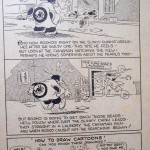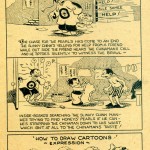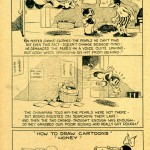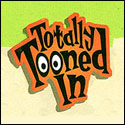
Alas, poor Bosko! I knew him well. The stretch-and-squash star of Warner Bros. Looney Tunes for three years, his rubber-hose antics became a victim of the “realism movement” in Hollywood cartoons of the mid-30s. In his new home at MGM, his earlier pie-eyed persona (poster, above left) only lasted two cartoons. Re-positioned as a realistic little black boy (poster, above right) the character appeared in some of the most elaborate fantasies Harman-Ising ever produced.
Bosko’s “last hurrah” in his earlier incarnation was in a series of comic strips – or rather, comic panels – begun by artist Robert Allen, and syndicated by “Red Ryder” cartoonist Fred Harman (Hugh’s brother). For one last time, from the collection of Martin Almeyra, we present a selection of rare Bosko comic clippings from the 1930s (these latter strips have been identified as being drawn by Win Smith, according to David Gerstein). These six panels begin a new adventure, which leave behind the native cannibals of the previous story – to depict even more racial stereotypes (Italian produce vendors, Chinese laundry men) than before. (Click the final four thumbnails below to enlarge)








 Jerry Beck is a writer, animation producer, college professor and author of more than 15 books on animation history. He is a former studio exec with Nickelodeon Movies and Disney, and has written for The Hollywood Reporter and Variety. He has curated cartoons for DVD and blu-ray compilations and has lent his expertise to dozens of bonus documentaries and audio commentaries on such. Beck is currently on the faculty of Cal Arts in Valencia, UCLA in Westwood and Woodbury University in Burbank – teaching animation history. More about Jerry Beck [
Jerry Beck is a writer, animation producer, college professor and author of more than 15 books on animation history. He is a former studio exec with Nickelodeon Movies and Disney, and has written for The Hollywood Reporter and Variety. He has curated cartoons for DVD and blu-ray compilations and has lent his expertise to dozens of bonus documentaries and audio commentaries on such. Beck is currently on the faculty of Cal Arts in Valencia, UCLA in Westwood and Woodbury University in Burbank – teaching animation history. More about Jerry Beck [







Thank you for sharing these wonderful comics.
Wow, the BOSKO comical strippers really did like their stereotypes, but I must admit to liking the MGM cartoons despite the stereotypes. It had some of the greatest action moments in all of the HAPPY HARMONIES series and there are far too many visual moments of brilliance throughout those cartoons to dismiss them as merely offensive. I guess I like to think of them for what Bosko and Honey could have been. My goodness, he was so much fun in his Warner Brothers incarnation, and he had a lot of interesting “jobs”, from race car driver to musketeer to champion boxer. Why did Harman leave these behind when it came to MGM? I don’t mind that they left him a kid, but the voice should have been that of a kid. And wouldn’t it have been all the more interesting if Bosko and Honey were both featured throughout the Bosko trilogy that capped off the series at MGM.
Is anything known about how long this strip lasted or how many papers — if any — carried it?
I remember that I had imaginary friends when I was a small child. Most were from cartoons I had seen on television circa 1956. My best friend was Bosko. I remember noticing that he seemed to disappear from the tv never to be seen or mentioned again, and around the same time a chocolate drink called Bosco appeared. I thought these two things were connected somehow. Roy Rogers took Bosko’s place.